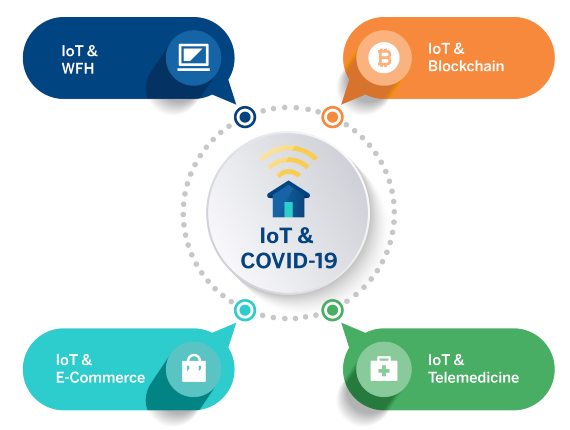COVID-19 has impacted countries, communities and individuals in countless ways, from business and school closures to job losses not to undermined loss of lives. As governments scramble to address these problems, different solutions based on technologies like IoT have sprung up to help in dealing with this worldwide health crisis. As a result, COVID-19 may well have been the ultimate catalyst of the Internet of Things (IoT). [3]
Internet of Things (IoT) platforms revenue will reach $66 billion in 2020, a 20% increase over last year’s figure. The increase in revenue will be generated, for example, by businesses seeking greater resilience in areas including supply chain and asset management, against external factors such as the disruption caused by the global COVID-19 pandemic. That will enable the IoT market to overcome the anticipated widespread economic disruption over 2020 and beyond. Meanwhile connected solutions are proving their worth in today’s crisis, making them a critical part of many organizations near-term technology roadmap. [1]
 Some of the areas where IoT will flourish because of COVID-19 impact:
Some of the areas where IoT will flourish because of COVID-19 impact:
IoT & work from home (WFH)
IoT consists of 4 components: Sensors, Networks, Cloud, and Applications (SNCA), and COVID-19 pushed their adoption and implementation to the max with the sudden pivot of many companies to Work From Home (WFH) option. Even before the pandemic, the IoT technologies that were of most interest to companies were sensors (84%), data processing (77%), and cloud platforms (76%).[2]
Remote working has been the standard for many companies for the last few months and will continue to be so wherever possible. It offers more flexibility, less time wasted on home-work trips, it allows companies to save on physical spaces, and to have teams working in different locations, IoT connected devices will make it more appealing and easy option for many organizations. [2]
IoT & Blockchain
With Blockchain we can share any transaction/information, real time, between relevant parties present as nodes in the chain in a secure and immutable fashion. In this case, had there been a blockchain network where WHO, Health Ministry of each country and may be even relevant nodal hospitals of each country, were connected, sharing real time information, about any new communicable disease, then the world might have woken up much earlier. We might have seen travel restrictions given sooner, quarantining policies set sooner and social distancing implemented faster. And may be fewer countries would have got impacted.
What every country is doing now fighting this pandemic, would have been restricted to fewer countries and in a much smaller scale. The usage of a Blockchain to share the information early on, might have saved the world a lot of pain and deaths. This is an area where IoT and Blockchain converged, with all the info. coming from the sensors/nodes and traveling over available networks to be process in the cloud and presented via applications in the hands of health workers and authorities, blockchain will secure the data all the way. [3]
IoT & E-Commerce
With the disruption of supply chain networks because of COVID-19, inventory control was one of the biggest challenges retailers and wholesalers had to face during lockdown – and this difficulty may continue until the end of the year. But indisputably, companies that were already using NFC labels for example to control inventory in and out of warehouses have had this task made easier. On the other hand, the track & trace systems used by some carrier companies have proved essential to keep the e-commerce in full operation and to manage the delays in deliveries in real-time. In other words, IoT has become a way to offer a faster and more transparent service to the final consumer. If the containment really changes our consumption habits, this could be one of the new demands.
IoT & Telemedicine
COVID-19 pandemic will kickstart IoT adoption in many sectors but especially in the healthcare sector, keeping in mind the strain on healthcare systems caused by the crisis has brought into focus the potential efficiency benefits that can be gained from remote monitoring in healthcare. The sector has been historically slow to integrate IoT technologies into its ecosystem, however, current researches anticipates that the continuing pandemic will drive the adoption of remote monitoring to minimize public interactions. [1]

The healthcare institutes in the world are facing difficulties in providing medical care and reducing the risk of exposure. Emphasis on contactless medical care drives the healthcare centers to look up to the IoT solution providers for an effective approach to tackle diseases.
The Internet of Medical Things (IoMT) along with cloud technologies and AI offers an opportunity to help healthcare professionals to monitor their patients, access the data and provide treatment from a remote location , this is possible by using devices like smart thermometers, smart wearables, track and trace apps, robots, and smart medical devices. [2]
Ahmed Banafa, Author the Books:
Secure and Smart Internet of Things (IoT) Using Blockchain and AI
Blockchain Technology and Applications
References
[1] https://futureiot.tech/analysts-say-covid-19-pandemic-will-spur-iot-adoption/
[2] https://blog.infraspeak.com/iot-covid-19/
[3] https://www.bbvaopenmind.com/en/technology/digital-world/blockchain-technology-and-covid-19/
Comments on this publication